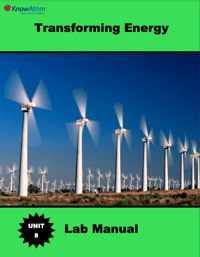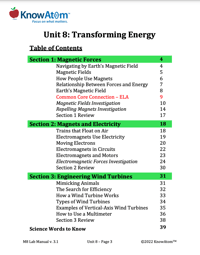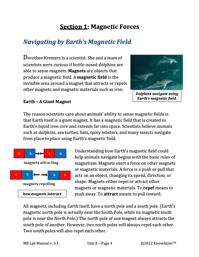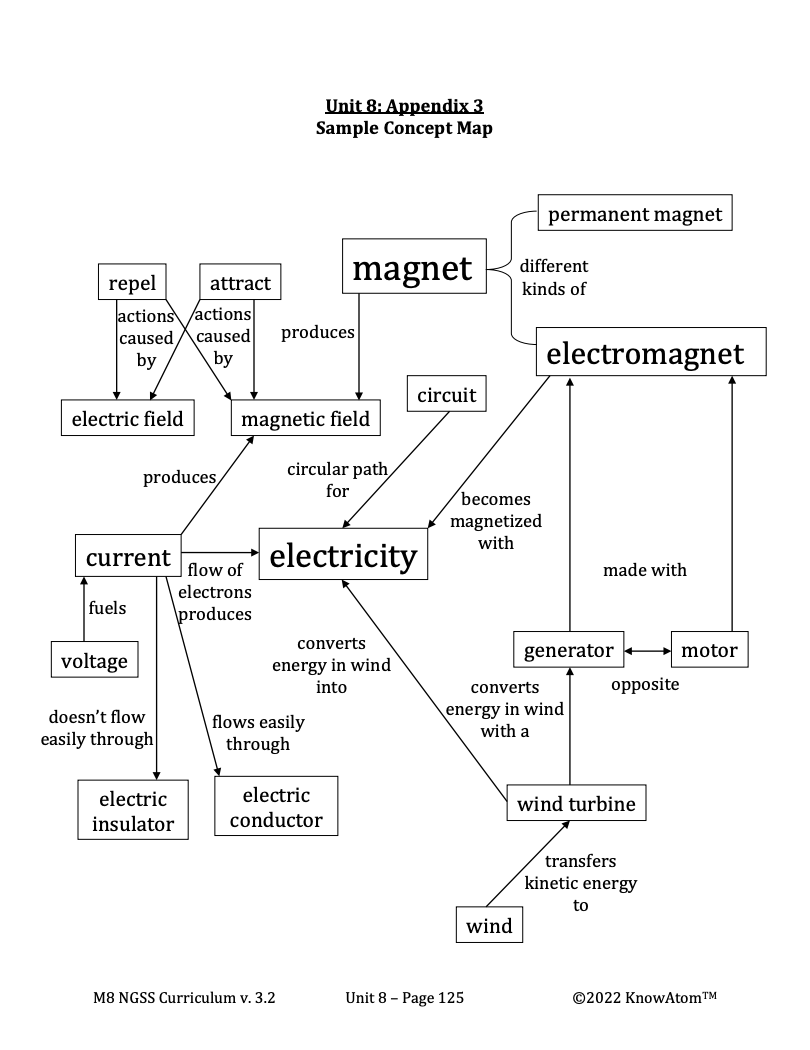Once students understand the basic principles of magnetism phenomena, they create simple electric motors using permanent magnets and electromagnets to investigate the factors that affect how fast the motor spins.
In this unit, students connect their discoveries about Earth and life sciences with the physical sciences as they figure out the relationship between magnetism phenomena and electricity phenomena. In this lesson, students investigate the interactions between magnets and electricity. This page is a high-level extract of this lesson.
Science background gives teachers more in-depth information on the phenomena students explore in this unit. Below is an excerpt from this section on electric and magnetic interactions.
Electricity is closely linked to magnetism. Charged particles change the space around them. They produce an electric field, which is the area around a charge that can exert a force on other charged particles. Similar to magnets, charged particles either attract or repel one another. Particles that have an opposite charge attract one another within their electric field, while particles with the same charge repel each other within their electric field. Electrons are kept in orbit in their shells because the positive charge of the protons in the nucleus attracts the negatively charged electrons.
The strength of the field weakens with distance. Because of this, electrons in shells closest to the nucleus are tightly bound, while electrons in the outermost shell are much more loosely bound. When a force is applied, electrons in the outer shells can be pushed from one atom to another. Once that first electron has been pushed away from its atom, it moves to another atom. This movement of electrons causes electrons to all move in the same direction as one another.
Because electromagnets are made with electricity, they can be demagnetized when the electricity is turned off. This is possible because electromagnets form a circuit. A circuit is the circular path that electrons travel in a negative to positive direction.
All circuits have the same basic parts, including an energy source such as a battery. The battery has stored chemical energy that converts to electrical energy. This energy provides the input of force that pushes the electrons in the conductive material through the circuit. A battery’s voltage affects how much it can push and pull electrons through a circuit. Voltage is a measure of the difference in electric charge between two points. A high voltage pushes and pulls electrons with more force than a low voltage. Voltage is measured in volts (v).
Circuits also have wires, which are the paths that electrons travel in the circuit. Energy moves from the battery through the conductors inside the wires. The wires in a circuit are attached to an object that can convert electrical energy to do work (any change in position, speed, or state of matter due to force). All circuits must include something that can do work. Without this part, the electricity will cause danger by overheating the circuit. This is called a “short circuit.”
For example, a light bulb is an object that does work. When electrons reach the light bulb in a circuit, they transfer electrical energy. The light bulb changes the electrical energy into outputs of light energy and heat. In a perfect system, the same amount of energy that was transferred through the circuit would be available to light up the bulb because of the conservation of energy. However, in the real world, some of the energy transfers out of the system due to resistance, which is the force opposing the current. The electrons then continue on their path. They return to the opposite side of the battery.
Finally, most circuits have switches. The switch opens and closes the circuit. Electrons flow when a circuit is closed. This is “on.” A closed circuit will cause the light bulb to light up. Electrons cannot flow when a circuit is open. This is “off.” No work can be done in an open circuit.
The way a circuit is put together affects the amount of electric current that can do work. Current is a measure of the rate that electric charge passes through a point in an electric circuit over time. It is measured in amps (A). The amount of work that can be done increases as current increases. For example, a fast current will cause a light bulb to be brighter than a slow current. This is because more electrons reach the bulb in the same amount of time.
As electrons in a conductor move in the same direction as one another, their movement produces a magnetic field around the wire conductor. The magnetic field around a straight wire is not very strong. However, if the wire is wrapped in a coil, the fields produced in each turn of the coil add up to create a stronger magnetic field. This is the idea behind an electromagnet: a tightly coiled wire produces a magnetic field when electricity passes through the wire. The electromagnet becomes magnetized when the circuit is closed. It becomes demagnetized when the circuit is open.
Electromagnets are an important part of electric motors, which are found in a wide range of household items, including electric screwdrivers, washing machines, automatic can openers, fans, electric toothbrushes, and many toys that move.
A motor is a machine that transfers an input of electrical energy into an output of kinetic energy. An electromagnetic motor has two parts: an outside permanent magnet and an inside electromagnet. The electromagnet becomes magnetized when the circuit it is part of is closed.
If the electromagnet is positioned so that its north pole is near the north pole of the permanent magnet, the two magnets will repel each other, and be attracted to each other’s south pole. These attracting and repelling forces cause the electromagnet to rotate, generating kinetic energy. This is the same basic concept behind maglev trains. If a gear is attached to the spinning electromagnet, the gear can be made to do work.
There are different ways to change the speed that a motor spins. The more coils an electromagnet has, the stronger magnetic field it will have. Because the electric current is so connected to the magnetic field, this stronger magnetic field causes the current to flow even faster. A faster current means that the electrons are moving faster. That faster movement creates a stronger magnetic field, which then causes the current to move even faster.
Once students understand the basic principles of magnetism phenomena, they create simple electric motors using permanent magnets and electromagnets to investigate the factors that affect how fast the motor spins.

Prepared hands-on materials, full year grade-specific curriculum, and personalized live professional development designed to support mastery of current state science standards.
Misconception: Electric charges and magnetic poles are the same thing so magnets can be attracted to or repulsed by electric charge.
Fact: Electric charges are different from magnetic poles, and do not affect magnets or magnetic materials.
Circuit : the circular path that electrons travel in a negative to positive direction
Current : a measure of the rate that an electric charge passes through a point in an electric circuit over time; measured in amps
Electric conductor : a material that electrons can easily pass through
Electric field : an area around a charged particle that attracts or repels other charged particles
Electric insulator : a material that electrons do not pass through easily
Electricity : the flow of electrons through a conductor
Electromagnet : a tightly wound coil of wire that produces a magnetic field when electricity passes through the wire
Motor : a machine that transfers an input of electrical energy into an output of kinetic energy
Permanent magnet : an object that stays magnetized without electricity
Voltage : a measure of the difference in electric charge between two points

Trains that Float on Air
The world’s fastest train is in Shanghai, a city in China. This train is called the Shanghai Maglev. It reaches speeds of 431 kilometers per hour (268 miles per hour). It can travel 30 kilometers (18.6 miles) in seven minutes and 20 seconds.
The Shanghai Maglev is able to reach such speeds because it uses giant magnets to float over the tracks. (Maglev is short for magnetic levitation.) Floating above the tracks offers the trains a significant advantage. There is very little friction to slow the trains down. Engineers in the United States are discussing using maglev trains to connect the East and West Coasts.
Maglev trains work because they use a kind of magnet called an electromagnet. Electromagnets are tightly wound coils of wire that produce a magnetic field when electricity passes through the wire. They are useful in various technologies because the magnet can be turned off and on. This is different from permanent magnets, which stay magnetized without electricity.
Electromagnets Use Electricity
Electromagnets become magnetized when electricity moves through the wire. Electricity is the flow of electrons through a conductor. Electricity is all around us. It is found in our bodies as electrical impulses and in the sky during storms as lightning. It also powers much of our modern world, turning on lights and powering motors, cell phones, and many other technologies.
Electricity happens because of the structure of matter. Remember that all matter is made of tiny particles called atoms. Atoms are made up of even smaller particles, including protons, neutrons, and electrons. Protons and neutrons are found in the nucleus, and electrons orbit the nucleus at different distances called shells. Protons have a positive charge (+), and electrons have a negative charge (-).
Interactions of Charged Particles
Charged particles change the space around them. They produce an electric field that can exert a force on other charged particles within the field. Similar to magnets, charged particles either attract or repel one another. Particles that have an opposite charge attract one another within their electric field, while particles with the same charge repel one another within their electric field.
Electrons are kept in orbit in their shells because the positive charges of the protons in the nucleus attract the negatively charged electrons. The strength of the field weakens with distance. Because of this, electrons in shells closest to the nucleus are tightly bound. Electrons in the outermost shell are much more loosely bound. When a force is applied, electrons in the outer shells can be pushed from one atom to another. Once that first electron has been pushed away from its atom, it moves to another atom. This movement of electrons causes electrons to all move in the same direction as one another. It is the movement of these electrons that creates electricity.


Moving Electrons
Electrons can move more easily through some materials than others. Electric conductors are materials that allow electrons to pass through them easily. Metals such as copper and aluminum are electric conductors because they have electrons that are loosely held, and therefore can easily be pushed from their shells by an outside force.
Electric insulators are materials that do not allow electrons to pass through easily because electrons do not easily separate from their atoms. Rubber and plastic are both good electric insulators. This is why electrical cords are covered in rubber or plastic. The electricity cannot travel through the rubber or plastic and is forced to follow the path on the aluminum or copper wires.
Some materials are semiconductors, which means they can sometimes act as a conductor, depending on what other molecules are around.
Electromagnets are Part of a Circuit
Because electromagnets are made with electricity, they can be demagnetized when the electricity is turned off. This is possible because electromagnets form a circuit. A circuit is the circular path that electrons travel in a negative to positive direction.
All circuits have the same basic parts. All circuits have an energy source such as a battery. The battery has stored chemical energy that converts to electrical energy, which is the energy of electrically charged particles. The battery’s energy provides the input of force that pushes the electrons in the conductive material through the circuit.
In this lesson students create simple electric motors using permanent magnets and electromagnets to figure out the factors that affect how fast the motor spins. Students use the data they gather in this activity to explain how electric motors use interactions between magnets and electricity to generate kinetic energy phenomena.
KnowAtom incorporates formative and summative assessments designed to make students thinking visible for deeper student-centered learning.

Standards citation: NGSS Lead States. 2013. Next Generation Science Standards: For States, By States. Washington, DC: The National Academies Press. Neither WestEd nor the lead states and partners that developed the Next Generation Science Standards were involved in the production of this product, and do not endorse it.